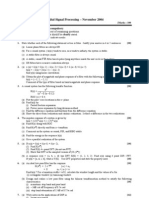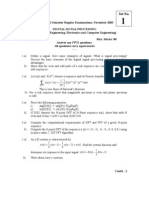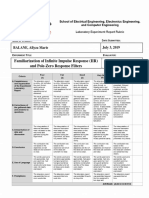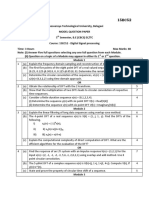H1Pzplot - JPG.: Coe 121 Programming Exercise 06: Frequency-Domain Analysis of Lti Systems 2 Semester 2018-2019
Uploaded by
Apricot BlueberryH1Pzplot - JPG.: Coe 121 Programming Exercise 06: Frequency-Domain Analysis of Lti Systems 2 Semester 2018-2019
Uploaded by
Apricot BlueberryCoE 121: Introduction to Digital Signal Processing
Electrical and Electronics Engineering Institute
University of the Philippines, Diliman
Programming Exercise 06: Frequency-Domain Analysis of LTI systems
INSTRUCTIONS
• This is an individual programming exercise. Any clarifications or questions must be
directed to the instructor or student assistant.
• Save your main code in an M-file with the file name CoE121_PE06_<LastName>.m.
Submit your code together with the following files.
o Documentation containing all the answers for each question. Save it as a pdf
file named CoE121_PE06_<LastName>_docu.pdf”.
o The required functions and images.
o Note: A missing file will incur a deduction of 10.
• The deadline of this exercise is on March 4, 4:00 PM. A 10-point deduction per day
will be incurred for late submissions.
FREQUENCY RESPONSE OF LINEAR, TIME-INVARIANT SYSTEMS
A linear time-invariant (LTI) system modifies the spectrum of the input signal according
to its frequency response. Its output has a spectrum expressed as
𝑌 (𝜔 ) = 𝐻 (𝜔 )𝑋 (𝜔 )
Since the LTI system will affect the input’s different frequency components differently, it
can be considered as a frequency-shaping filter. The effect on the system on different
frequencies can be analyzed by looking at its poles and zeros.
In this exercise, we are going to investigate the effect of poles and zeros in the
frequency response, and use it in the design of simple digital filters.
LOWPASS AND HIGHPASS FILTERS
In this part of the exercise we are going to start with the system described by this
function.
1−𝑎
𝐻1 (𝑧) =
1 − 𝑎𝑧 −1
Note that the frequency response can be obtained by evaluating the system function on
the unit circle (z = ejw). The system has a single pole at a, and a zero at the origin. The
gain was chosen as 1 – a so that it will have a unity gain at ω = 0.
1. (5 POINTS) Plot the magnitude and phase response of the system 𝐻1 (𝑧) at 𝑎 = 0.9,
using the function freqz(). Use the following lines of code.
>> num1 = [0.1, 0]; den1 = [1, -0.9];
>> w = [0:1:100]*pi/100; H = freqz(num1,den1,w);
>> magH = abs(H); phaH = angle(H);
>> subplot(2,1,1); plot(w/pi,magH); grid;
>> xlabel(‘Frequency in \pi units’); ylabel(‘Magnitude’);
>> title(‘Magnitude Response’);
>> subplot(2,1,2); plot(w/pi,phaH/pi); grid;
>> xlabel(‘Frequency in \pi units’); ylabel(‘Phase in \pi units’);
>> title(‘Phase Response’);
Describe the system in terms of its magnitude response. What kind of filter is it?
2. (5 POINTS) Generate the pole-zero plot of the system 𝐻1(𝑧) using the zplane()
function in MATLAB. Verify the location of the pole and the zero. Save your figure as
<LastName>_H1PZPlot.jpg.
CoE 121 Programming Exercise 06: Frequency-Domain Analysis of LTI systems
2nd Semester 2018-2019
CoE 121: Introduction to Digital Signal Processing
Electrical and Electronics Engineering Institute
University of the Philippines, Diliman
3. (10 POINTS) Vary the value of a and observe its effect on the frequency response.
Use a = 0.9, a = 0.7, and a = 0.5. Superimpose the magnitude response plots in one
subplot, and all phase response plots in another. Properly label your plots and add
legends if necessary. Save your figure as <LastName>_H1FreqRep_VaryA.jpg.
Also generate the pole-zero plots for each value of a. Relate the frequency response
to the position of the pole. Write down your observations.
4. (5 POINTS) A similar system is implemented using the following system function.
1 − 𝑎 1 + 𝑧 −1
𝐻2 (𝑧) = ̇
2 1 − 𝑎𝑧 −1
The system now has a different zero and the gain has been adjusted so that |H 2(ω)|
= 1 at ω = 0.
Generate the pole-zero plot of 𝐻2 (𝑧) and save it as <LastName>_H2PZ.jpg. Use a =
0.9. Where is the zero located in terms of ω?
5. (10 POINTS) Plot the magnitude and phase response of both 𝐻1 (𝑧) and 𝐻2 (𝑧)
(superimposed) and save it as <LastName>_H1n2FreqRep.jpg. Compare the two
systems. What is the effect of adding a zero at that value of ω?
6. (10 POINTS) Generate the pole-zero plot and the frequency response of the following
system. Use a = 0.9.
1 − 𝑎 1 − 𝑧 −1
𝐻3 (𝑧) = ̇
2 1 + 𝑎𝑧 −1
Note that the system differs from 𝐻2 (𝑧) by a few changes in sign. Where are the zero
and pole now located and how does this affect the frequency response? What kind of
filter is 𝐻3(𝑧)?
7. (10 POINTS) Vary the value of a and observe its effect on the frequency response.
Use a = 0.9, a = 0.7, and a = 0.5. Superimpose the magnitude response plots in one
subplot, and all phase response plots in another. Properly label your plots and add
legends if necessary. Save your figure as <LastName>_H3FreqRep_VaryA.jpg.
Also generate the pole-zero plots for each value of a. Relate the frequency response
to the position of the pole. Write down your observations.
8. (5 POINTS) Based on the exercise above, summarize the design of lowpass and
highpass filters in terms of pole and zero locations.
BANDPASS FILTERS
In this part of the exercise we are going to use the system described by the following
function.
(𝑧 − 1)(𝑧 + 1)
𝐻4 (𝑧) = 𝐺
(𝑧 − 𝑗𝑟)(𝑧 + 𝑗𝑟)
The system has two zeros at ±1 and two poles at 𝑟𝑒 ±𝑗0.5𝜋 .
1. (10 POINTS) Determine G so that the system will have unity gain at the location of
the poles. Express it as a function of r.
2. (10 POINTS) Suppose we want the system to have a magnitude response of 1/√2 at
𝜔 = 3𝜋/5. What is the value of r?
CoE 121 Programming Exercise 06: Frequency-Domain Analysis of LTI systems
2nd Semester 2018-2019
CoE 121: Introduction to Digital Signal Processing
Electrical and Electronics Engineering Institute
University of the Philippines, Diliman
3. (10 POINTS) Generate the pole-zero plot and the frequency response of the system.
Save the figures as <LastName>_H4PZPlot.jpg and <LastName>_H4FreqRep.jpg.
CoE 121 Programming Exercise 06: Frequency-Domain Analysis of LTI systems
2nd Semester 2018-2019
You might also like
- B. Frequency Domain Representation of Lti Systems: Objective100% (1)B. Frequency Domain Representation of Lti Systems: Objective4 pages
- Lab No:8: Frequency Response of Discrete Time SystemNo ratings yetLab No:8: Frequency Response of Discrete Time System5 pages
- EE-235 Summer 2011 Signals & Systems Leo LamNo ratings yetEE-235 Summer 2011 Signals & Systems Leo Lam6 pages
- 2022 Set A PYQ Paper - Digital Signal Processing PYQ Paper For Sem V Uploaded by Navdeep Raghav (DU Academic Corner)No ratings yet2022 Set A PYQ Paper - Digital Signal Processing PYQ Paper For Sem V Uploaded by Navdeep Raghav (DU Academic Corner)4 pages
- LAB 6 - Analysis of LTI Systems in the z-DomainNo ratings yetLAB 6 - Analysis of LTI Systems in the z-Domain14 pages
- Hochschule Offenburg - University of Applied Sciences Written Examination Digital Signals and Systems - CMEI WS2006/07No ratings yetHochschule Offenburg - University of Applied Sciences Written Examination Digital Signals and Systems - CMEI WS2006/072 pages
- Problem Set No. 6: Sabancı University Faculty of Engineering and Natural Sciences Ens 211 - SignalsNo ratings yetProblem Set No. 6: Sabancı University Faculty of Engineering and Natural Sciences Ens 211 - Signals6 pages
- Hochschule Offenburg - University of Applied Sciences Written Examination Digital Signals and Systems - CME1 WS 2010/11No ratings yetHochschule Offenburg - University of Applied Sciences Written Examination Digital Signals and Systems - CME1 WS 2010/111 page
- B.Tech (EC, VI SEM) : Ii) All Questions Carry Equal MarksNo ratings yetB.Tech (EC, VI SEM) : Ii) All Questions Carry Equal Marks2 pages
- FUNDAMENTALS OF DIGITAL SIGNAL PROCESSING_AEIE 3104_2023No ratings yetFUNDAMENTALS OF DIGITAL SIGNAL PROCESSING_AEIE 3104_20234 pages
- Rochschelle Offenburg - Applied Sciences Dfcrita1 Sfo-Nah 3.Nd Sustemr Ci/Fel ,/vs 20G7/Q8No ratings yetRochschelle Offenburg - Applied Sciences Dfcrita1 Sfo-Nah 3.Nd Sustemr Ci/Fel ,/vs 20G7/Q81 page
- Nonlinear Control Feedback Linearization Sliding Mode ControlFrom EverandNonlinear Control Feedback Linearization Sliding Mode ControlNo ratings yet
- Student Solutions Manual to Accompany Economic Dynamics in Discrete Time, secondeditionFrom EverandStudent Solutions Manual to Accompany Economic Dynamics in Discrete Time, secondedition4.5/5 (2)
- A Brief Introduction to MATLAB: Taken From the Book "MATLAB for Beginners: A Gentle Approach"From EverandA Brief Introduction to MATLAB: Taken From the Book "MATLAB for Beginners: A Gentle Approach"2.5/5 (2)
- Assignment (ERD) : Cairo University Faculty of Computers and Information Information Systems Department Database Systems 1No ratings yetAssignment (ERD) : Cairo University Faculty of Computers and Information Information Systems Department Database Systems 14 pages
- PCA, Eigenfaces, and Face Detection: CSC320: Introduction To Visual Computing Michael GuerzhoyNo ratings yetPCA, Eigenfaces, and Face Detection: CSC320: Introduction To Visual Computing Michael Guerzhoy30 pages
- Grade 3 - Connect - Final Revision - First TermNo ratings yetGrade 3 - Connect - Final Revision - First Term9 pages
- Introduction To Sustainable Infrastructure Assessment Tool As A Framework For Viable Project Development: ISCA IS ToolNo ratings yetIntroduction To Sustainable Infrastructure Assessment Tool As A Framework For Viable Project Development: ISCA IS Tool19 pages
- 5E - Lost Lands - The Blight - TB1 The Crooked Nail (LVL 1)100% (4)5E - Lost Lands - The Blight - TB1 The Crooked Nail (LVL 1)39 pages
- What Is Cut Off Ratio in Diesel Cycle?: Answer Follow 23 RequestNo ratings yetWhat Is Cut Off Ratio in Diesel Cycle?: Answer Follow 23 Request4 pages
- Rehabilitation and Resettlement at Tata Steel Kalinga Nagar Project, Orissa100% (1)Rehabilitation and Resettlement at Tata Steel Kalinga Nagar Project, Orissa40 pages
- Eckhart Tolle and The Fallacies of Borrowed BuddhismNo ratings yetEckhart Tolle and The Fallacies of Borrowed Buddhism3 pages
- Module 3: Sampling and Reconstruction Problem Set 3No ratings yetModule 3: Sampling and Reconstruction Problem Set 320 pages
- Sulky 12 Color 3mm Puffy Foam Assortment - Two Pack Ghana UbuyNo ratings yetSulky 12 Color 3mm Puffy Foam Assortment - Two Pack Ghana Ubuy1 page
- Transportation Case Digest: Calvo V. UCPB Gen Insurance Co. (2002)No ratings yetTransportation Case Digest: Calvo V. UCPB Gen Insurance Co. (2002)3 pages



































































































